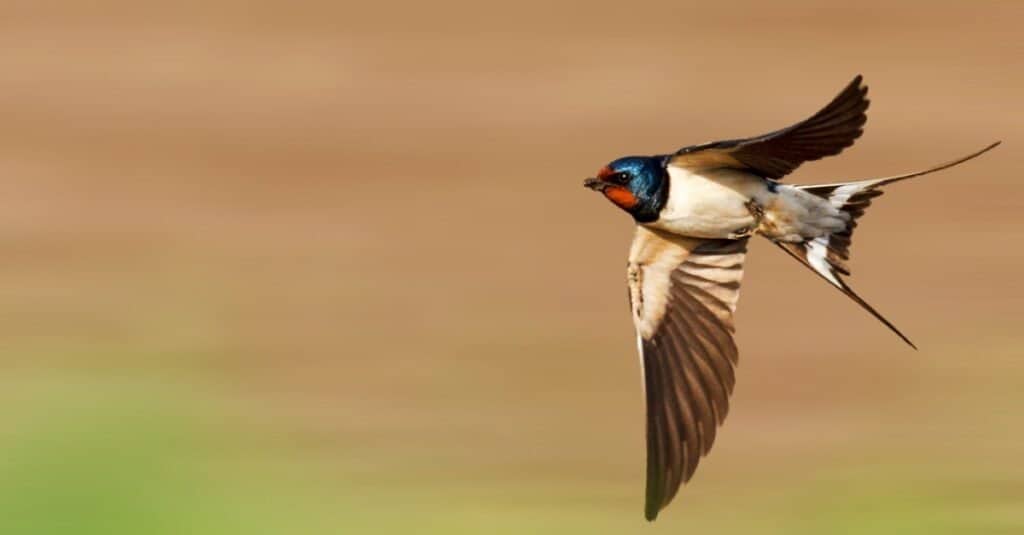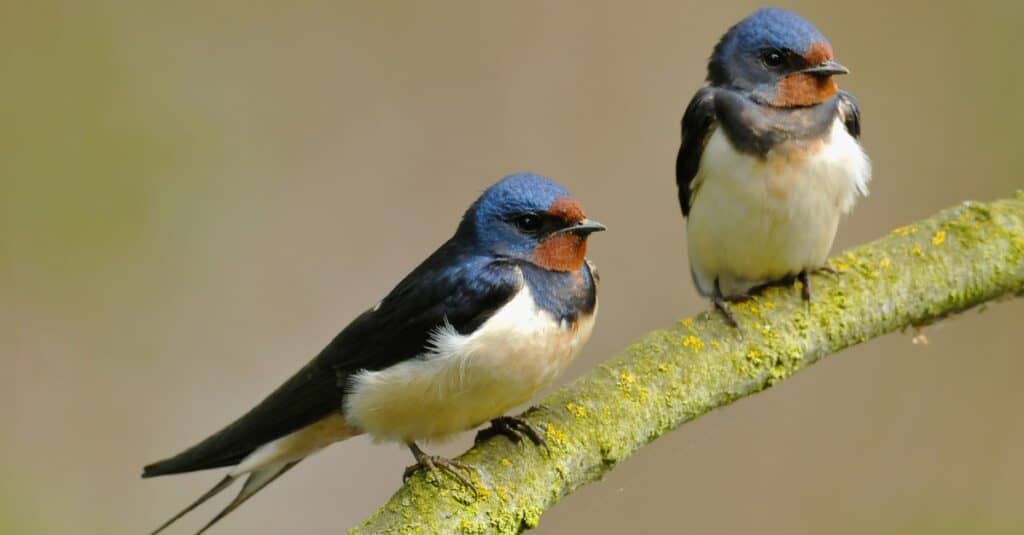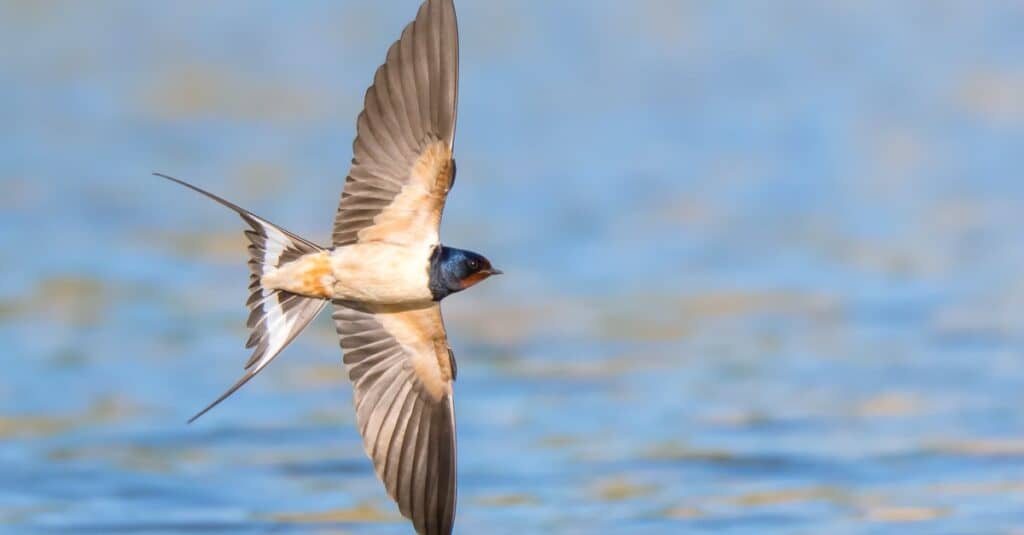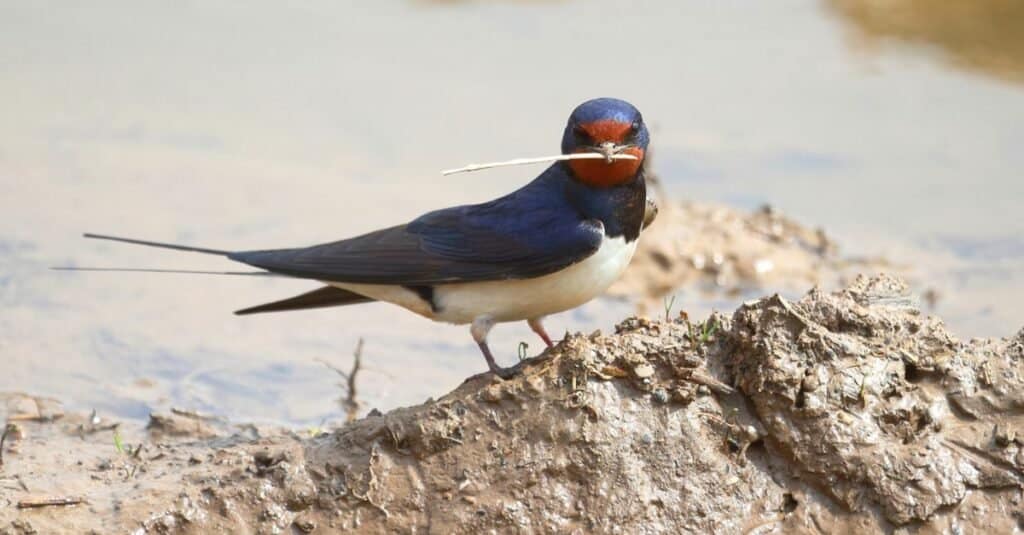Have you spotted a barn swallow around your house, and you’re wondering what it eats and how you can make your garden an appealing habitat? No worries, we’ve got the answers! Keep reading to find out everything about a barn swallow’s feeding behavior!
What Are Barn Swallows?

Barn swallows can be found in Asia, Africa, the Americas, and Europe.
©iStock.com/drakuliren
Barn swallows are scientifically called Hirundo rustica. This bird species is the world’s most widespread swallow species! They can be found in Asia, Africa, the Americas, and Europe. There are six barn swallow subspecies:
- Hirundo rustica rustica
- Hirundo rustica transitiva
- Hirundo rustica savignii
- Hirundo rustica gutturalis
- Hirundo rustica tytleri
- Hirundo rustica erythrogaster
Four subspecies are migratory and prefer wintering in the Southern Hemisphere. Otherwise, they’ll live close to cities because they use artificial structures for breeding and nesting.
Hirundo rustica rustica measures 6.5 – 7.5 inches long, has a wingspan of 12.5 – 13.5 inches, and weighs 0.56 – 0.75 ounces. Their upper parts are steel blue, while their foreheads, chins, and throats are rufous.
These birds have an average flying speed of 24.9 mph, rarely reaching 44.7 mph. They have a wing beat rate of up to 9 times per second.
What Do Barn Swallows Eat?

Barn swallows eat crickets, beetles, dragonflies, grasshoppers, and moths.
©CezaryKorkosz/Shutterstock.com
Barn swallows are insectivores and eat mostly flies and aphids. In Europe, they feed on house martins and sand martins. During winter, barn swallows primarily rely on ants and dead or sluggish insects because the weather isn’t favorable for flying.
These migratory birds can also eat crickets, beetles, dragonflies, grasshoppers, and moths.
People sometimes feed barn swallows with crushed oyster shells and eggshells because they are rich in calcium and help digest the food.
A List of Foods Barn Swallows Eat
Here’s a list of foods barn swallows eat:
- Wasps
- House flies
- Beetles
- Horseflies
- Moths
- Grasshoppers
- Damselflies
- Snails
- Spiders
- True bugs
- Wild bees
- House martins
- Sand martins
- Ants
- Dead insects
What Do Baby Barn Swallows Eat?
Baby barn swallows rely on their parents to bring them food until they leave their nests. They usually leave the nest approximately 18-23 days after hatching. Sometimes adult barn swallows will feed the young a week or so after they leave the nest.
Studies show that a baby barn swallows’ diet should include carotenoids that boost their immune system function.
How Do Barn Swallows Find Food?

Barn swallows catch insects on the water surface or from plants or walls.
©Mirko Graul/Shutterstock.com
Barn swallows enjoy feeding in open areas, 23 – 26 feet above the ground. They drink water by skimming low over rivers or lakes. Sometimes they may catch insects on the water surface or from plants or walls. They would often fly in large flocks while looking for food.
Are Barn Swallows Good To Have Around?
Having a barn swallow around your house in the summer is definitely a blessing! A single bird can eat up to 850 insects per day! These birds will clean your surroundings of insects, mosquitoes, bugs, and flying termites.
Moreover, if the weather suddenly worsens, you may be able to help the barn swallows in the area. Since they primarily feed while flying, bad weather would mean less food. If the weather keeps getting worse, these birds may need supplements to function normally.
However, until the barn swallows get familiar with you and your pets, you should be gentle with them. If they feel threatened, they may act territorial and become vocal, producing alarm calls. They’re also extremely protective of their eggs and babies.
How To Attract Barn Swallows

Barn swallows prefer open areas with grass and water.
©PavlovaSvetlana/Shutterstock.com
If you live on a farm, you can rest assured that barn swallows will naturally find your house! They can build their nests there and find fields and ponds for flying and foraging. Moreover, the farm livestock will attract insects, so barn swallows will be delighted to live on a farm!
If you do not live on a farm, you may find it challenging to attract barn swallows to your garden. However, here are some tips on how to make your ecosystem appealing to them:
- Barn swallows prefer open areas with grass and water, so if you have lots of brushes and weeds in your garden, you can try killing some to make space for the birds.
- Barn swallows like having access to buildings, so you can leave a door open to welcome the birds into your house.
- Ensure they have enough space for a nest. If you can, set up a shelf or a platform that would facilitate the nest-making process.
- If you have old bird nests in your garden, you can leave them for barn swallows. One day, a bird will find it and call it home.
- You can hang artificial nesting shelves or nest cups.
Barn Swallow Fun Facts
If you’re a bird enthusiast, you’ll definitely enjoy some barn swallow fun facts! There’s much more to them than just their interesting feeding behavior!
- During winter, barn swallows go to warmer countries and may fly as much as 5,600 miles!
- Barn swallows have an average lifespan of 4 years.
- Female and male barn swallows have separate responsibilities in the family. Females are responsible for incubation, while males build the nest and feed their babies.
- Barn swallows like to inhabit agricultural fields, beaches, suburban parks, and areas around lakes, ponds, or coastal waters.
- Barn swallows communicate through vocalizations, which they learn when they are very young. If they feel threatened, they’ll produce alarm calls, which sometimes scare predators away.
Up Next:
- Cliff Swallow vs. Barn Swallow: What are the Differences?
- Sparrow vs. Swallow: Key Differences Explained
- 11 Best Types Of Swallow Birds
The photo featured at the top of this post is © CezaryKorkosz/Shutterstock.com
Sources
- Mother Earth News, Available here: https://www.motherearthnews.com/sustainable-living/nature-and-environment/attracting-barn-swallows-to-your-property-zbcz1802/
- CBC, Available here: https://www.cbc.ca/news/canada/prince-edward-island/pei-barn-swallow-wildlife-facts-1.3637139
- Google Books, Available here: https://books.google.ro/books?hl=en&lr=&id=HxjSBAAAQBAJ&oi=fnd&pg=PP1&dq=barn+swallow&ots=nMn6xalKX5&sig=2cvYhLjsnwa-VcDI-JmKZP7Z-6E&redir_esc=y#v=onepage&q&f=false
- BirdNote, Available here: https://www.birdnote.org/listen/shows/barn-swallow-natural-pest-control
Thank you for reading! Have some feedback for us? Contact the AZ Animals editorial team.






